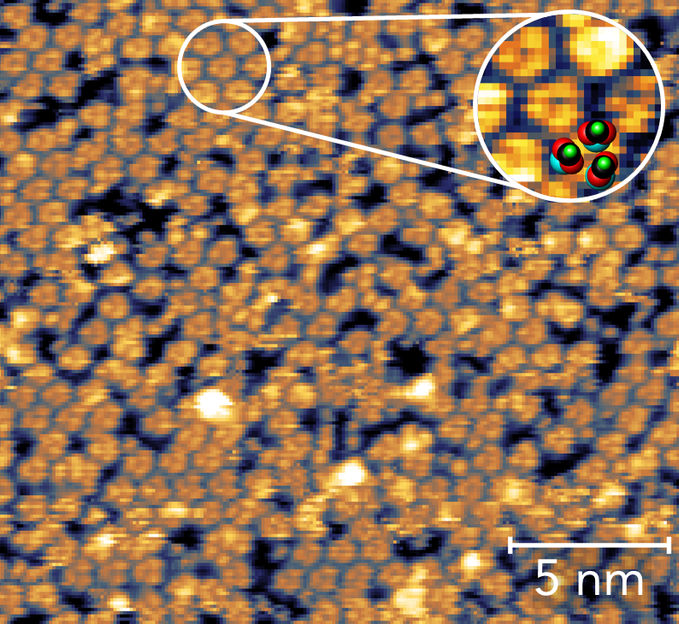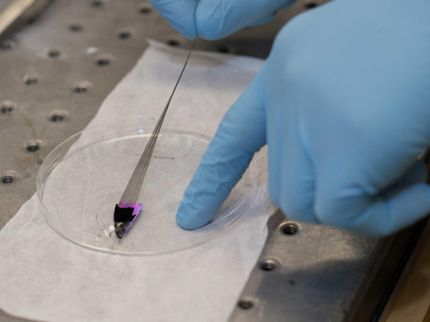Molecular Needles: Carbon nanotubes inject antimycotics into cells and increase their effectiveness
Putting pharmaceutical agents into the body isn't hard, but getting them into targeted areas can be problematic. If drugs aren't taken up by a large enough proportion of cells, a suitable "transport agent" must be used. A French and Italian research team has successfully used carbon nanotubes as transport agents for antimycotics (antifungal agents). In addition, they have developed a strategy for attaching a second agent or marker to the nanotubes in a controlled fashion.
Carbon nanotubes are long, narrow nanoscale tubes made of multiple layers of carbon atoms arranged in graphite-like sheets. "They can drill through cell membranes like tiny needles," explains Alberto Bianco, "without damaging the cell." If proteins or nucleic acids are attached to the nanotubes, they come right along through the membrane. Bianco and a team of scientists from CNRS (Centre National de la Recherche Scientifique of Strasbourg) and the University of Trieste wanted to determine if this concept could also be extended to small pharmaceutical molecules such as antibiotics or cancer drugs. They were particularly intrigued by the idea of attaching not one, but two different "passengers". This would make it possible to carry out combination therapies with two different drugs or to trace the uptake of a drug by using a marker.
Attaching two different molecules to a carbon nanotube in a targeted, controlled, and fully independent manner requires a clever strategy. The researchers thus put two different types of anchor sites, equipped with protective "caps", on the tips and sides walls of the tubes. They removed the first type of "cap" and attached one kind of molecule, then removed the second type of cap and attached another type of molecule. The researchers thus loaded the nanotubes with the antimycotic amphotericin B, as well as a fluorescence dye.
When coupled to the nanotubes, the drug loses the toxic side effects typical of treatment with amphotericin B. At the same time, its effectiveness against fungi is improved. One reason for this could be the improved solubility in water; in addition, the amphotericin is prevented from forming clumps. "Our approach could help amphotericin B become more widely used against chronic fungal infections," hopes Bianco.
A particularly attractive target is carbon nanotubes equipped with both a drug and a "guide". The guide could then recognize certain types of cells, such as tumor cells, and could conduct the transporter to these cells to deliver the drug preferentially to where it is needed.
Original publication: A. Bianco; "Targeted Delivery of Amphotericin B to Cells by Using Functionalized Carbon Nanotubes"; Angewandte Chemie International Edition 2005.
Topics
Organizations
Related link
Other news from the department science
These products might interest you

Anopore™ by Cytiva
Precise filtration made easy with Anopore inorganic membranes
The aluminum oxide filter membrane that can increase the purity or yield of your analyte

Hahnemühle LifeScience Catalogue Industry & Laboratory by Hahnemühle
Wide variety of Filter Papers for all Laboratory and Industrial Applications
Filtration Solutions in the Life Sciences, Chemical and Pharmaceutical Sectors

Get the chemical industry in your inbox
By submitting this form you agree that LUMITOS AG will send you the newsletter(s) selected above by email. Your data will not be passed on to third parties. Your data will be stored and processed in accordance with our data protection regulations. LUMITOS may contact you by email for the purpose of advertising or market and opinion surveys. You can revoke your consent at any time without giving reasons to LUMITOS AG, Ernst-Augustin-Str. 2, 12489 Berlin, Germany or by e-mail at revoke@lumitos.com with effect for the future. In addition, each email contains a link to unsubscribe from the corresponding newsletter.
Most read news
More news from our other portals
Last viewed contents
MWG Biotech: Statement on the Chip Patent Situation
Sunil_Industry
BASF boosts capacity for highly chromatic yellow pigments
New flow battery could enable cheaper energy storage - Design may support widespread use of solar and wind energy
Thermo Fisher Scientific Launches Program to Meet Melamine Detection Challenges




























































